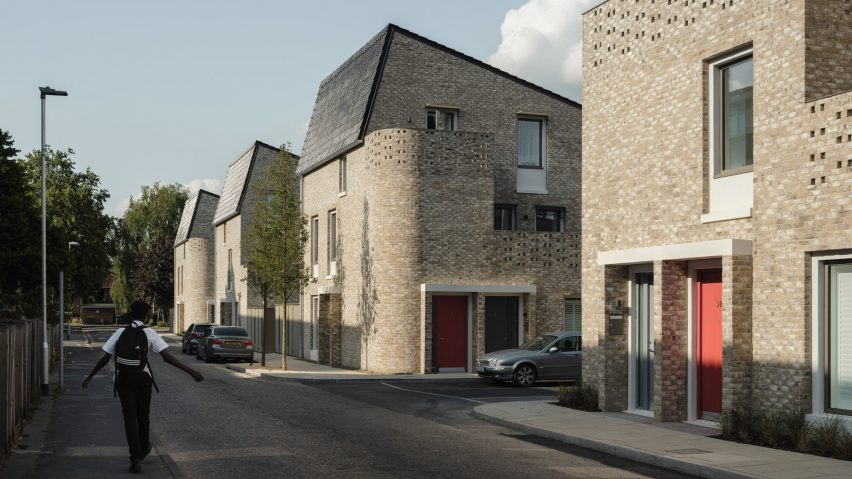The Passivhaus and high-density Goldsmith Street social housing scheme designed by Mikhail Riches with Cathy Hawley has been awarded the RIBA Stirling Prize 2019.
London studio Mikhail Riches, led by architects David Mikhail and Annalie Riches, has won the biggest prize in UK architecture for the residential scheme in Norwich.
Goldsmith Street, which has provided Norwich City Council with 105 low-energy homes, was hailed by the jury as "a ground-breaking project and an outstanding contribution to British architecture".
RIBA president Alan Jones described the project as "a beacon of hope".
"Faced with a global climate emergency, the worst housing crisis for generations and crippling local authority cuts, Goldsmith Street is a beacon of hope," he said. "It is commended not just as a transformative social housing scheme and eco-development, but a pioneering exemplar for other local authorities to follow."
Located close to Norwich city centre, Goldsmith Street was designed by Mikhail Riches with Cathy Hawley as an affordable high-density alternative to apartment blocks.
The development comprises seven terraced blocks arranged in four lines, containing a total of 45 houses and 60 flats, within an area of less than one hectare.
Each home faces south to maximise solar gain and is designed by Mikhail Riches to meet Passivhaus standard.
Over a quarter of the site is dedicated to communal space to encourage social cohesion – including an open alley that runs through the centre of the scheme that doubles as a shared communal garden and safe play area for children.
"Goldsmith Street's success is testimony to the vision and leadership of Norwich City Council. We thank them for their commitment and support. They believe that council housing tenants deserve great design," said Mikhail.
"It is not often we are appointed to work on a project so closely aligned with what we believe matters; buildings people love which are low impact," he continued. "We hope other local authorities will be inspired to deliver beautiful homes for people who need them the most, and at an affordable price."
The Stirling Prize 2019 judging panel, chaired by Julia Barfield, described the project as "a modest masterpiece".
"It is high-quality architecture in its purest most environmentally and socially-conscious form. Behind restrained creamy facades are impeccably detailed, highly sustainable homes – an incredible achievement for a development of this scale," the jury added.
"This is proper social housing, over ten years in the making, delivered by an ambitious and thoughtful council. These desirable, spacious, low-energy properties should be the norm for all council housing."
RIBA's Stirling Prize has been awarded annually since 1996 to buildings deemed to have made the most significant impact to British architecture in the past year. This year marks the first time that the prize has gone to social housing.
Goldsmith Street also won the inaugural Neave Brown Award for Housing, given in memory of the Royal Gold Medal-winning architect who designed the Alexandra Road Estate in north London.
The five other projects shortlisted for this year's Stirling Prize were The Macallan Distillery by Rogers Stirk Harbour + Partners, Nevill Holt Opera by Witherford Watson Mann Architects, Cork House by Matthew Barnett Howland with Dido Milne and Oliver Wilton, London Bridge Station by Grimshaw, and The Weston by Feilden Fowles Architects.
Last year, Foster + Partners won the award for Bloomberg's European HQ in London. It was the third time the studio was presented the prize, receiving it in 1998 for the Imperial War Museum in Duxford, and again for 30 St Mary Axe – also known as the Gherkin – in 2004.
Photography is by Tim Crocker.

